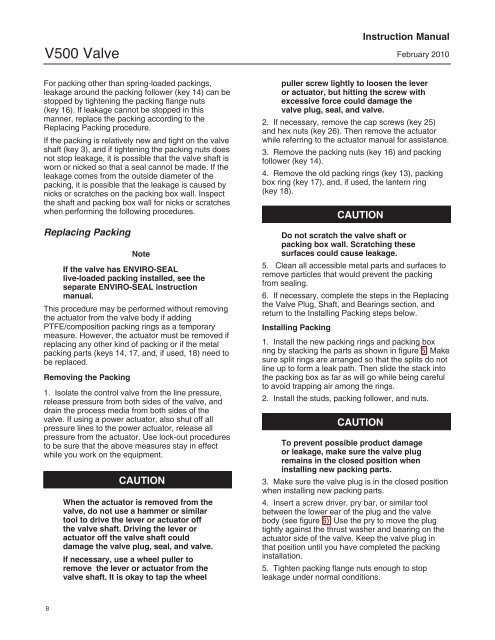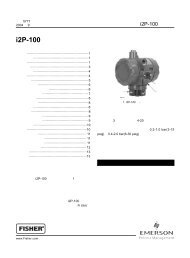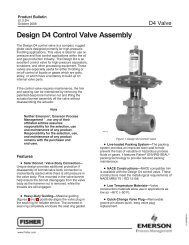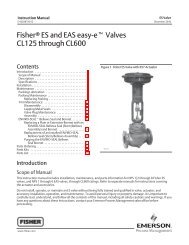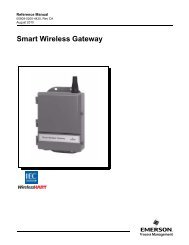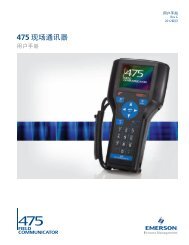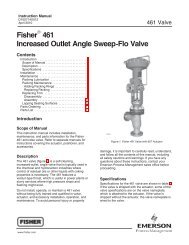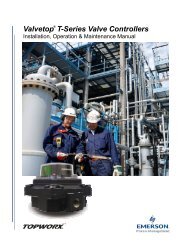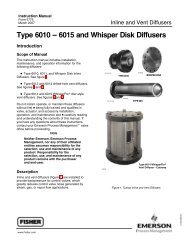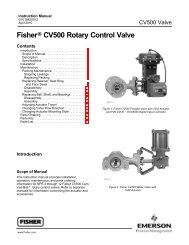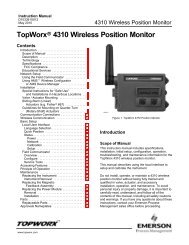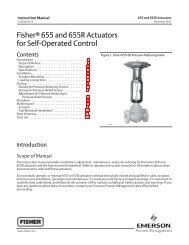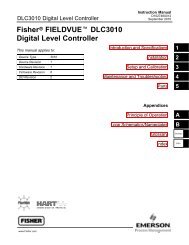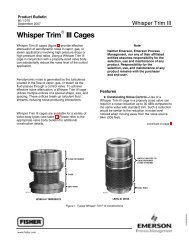Fisher V500 Rotary Control Valve
Fisher V500 Rotary Control Valve
Fisher V500 Rotary Control Valve
Create successful ePaper yourself
Turn your PDF publications into a flip-book with our unique Google optimized e-Paper software.
<strong>V500</strong> <strong>Valve</strong>Instruction ManualFebruary 2010For packing other than spring-loaded packings,leakage around the packing follower (key 14) can bestopped by tightening the packing flange nuts(key 16). If leakage cannot be stopped in thismanner, replace the packing according to theReplacing Packing procedure.If the packing is relatively new and tight on the valveshaft (key 3), and if tightening the packing nuts doesnot stop leakage, it is possible that the valve shaft isworn or nicked so that a seal cannot be made. If theleakage comes from the outside diameter of thepacking, it is possible that the leakage is caused bynicks or scratches on the packing box wall. Inspectthe shaft and packing box wall for nicks or scratcheswhen performing the following procedures.Replacing PackingNoteIf the valve has ENVIRO-SEALlive-loaded packing installed, see theseparate ENVIRO-SEAL instructionmanual.This procedure may be performed without removingthe actuator from the valve body if addingPTFE/composition packing rings as a temporarymeasure. However, the actuator must be removed ifreplacing any other kind of packing or if the metalpacking parts (keys 14, 17, and, if used, 18) need tobe replaced.Removing the Packing1. Isolate the control valve from the line pressure,release pressure from both sides of the valve, anddrain the process media from both sides of thevalve. If using a power actuator, also shut off allpressure lines to the power actuator, release allpressure from the actuator. Use lock-out proceduresto be sure that the above measures stay in effectwhile you work on the equipment.CAUTIONWhen the actuator is removed from thevalve, do not use a hammer or similartool to drive the lever or actuator offthe valve shaft. Driving the lever oractuator off the valve shaft coulddamage the valve plug, seal, and valve.If necessary, use a wheel puller toremove the lever or actuator from thevalve shaft. It is okay to tap the wheelpuller screw lightly to loosen the leveror actuator, but hitting the screw withexcessive force could damage thevalve plug, seal, and valve.2. If necessary, remove the cap screws (key 25)and hex nuts (key 26). Then remove the actuatorwhile referring to the actuator manual for assistance.3. Remove the packing nuts (key 16) and packingfollower (key 14).4. Remove the old packing rings (key 13), packingbox ring (key 17), and, if used, the lantern ring(key 18).CAUTIONDo not scratch the valve shaft orpacking box wall. Scratching thesesurfaces could cause leakage.5. Clean all accessible metal parts and surfaces toremove particles that would prevent the packingfrom sealing.6. If necessary, complete the steps in the Replacingthe <strong>Valve</strong> Plug, Shaft, and Bearings section, andreturn to the Installing Packing steps below.Installing Packing1. Install the new packing rings and packing boxring by stacking the parts as shown in figure 5. Makesure split rings are arranged so that the splits do notline up to form a leak path. Then slide the stack intothe packing box as far as will go while being carefulto avoid trapping air among the rings.2. Install the studs, packing follower, and nuts.CAUTIONTo prevent possible product damageor leakage, make sure the valve plugremains in the closed position wheninstalling new packing parts.3. Make sure the valve plug is in the closed positionwhen installing new packing parts.4. Insert a screw driver, pry bar, or similar toolbetween the lower ear of the plug and the valvebody (see figure 6). Use the pry to move the plugtightly against the thrust washer and bearing on theactuator side of the valve. Keep the valve plug inthat position until you have completed the packinginstallation.5. Tighten packing flange nuts enough to stopleakage under normal conditions.8


